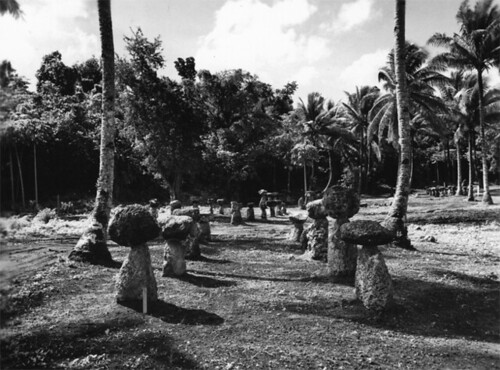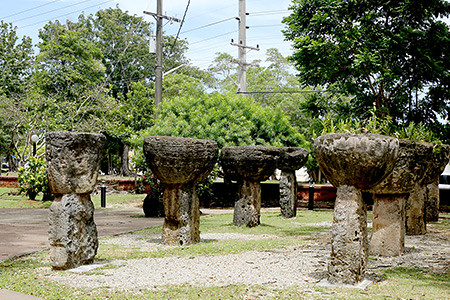Latte
Stone pillars and capstones
Latte (also latde) is a CHamoru term that refers to stone pillars and cup-shaped capitals or capstones, which represent house supports and are ascribed to the ancient people of the Mariana Islands. In some accounts, they are also referred to as casas de los antiguos (houses of the ancients).
When relatively undisturbed, latte can be found at ancient sites in two parallel rows of pillars that enclose a rectangular space. While megalithic construction is widespread in Oceania, no other culture is known to have used this particular form of stone architecture: limestone, basalt, or sandstone pillars and capstones arranged in sets of six, eight, ten, twelve or fourteen pillar-and-capstone pairs. The pillars vary in height from about sixty centimeters to more than three meters and are generally wide at the base and narrow at the top.
Latte resemble wood post constructions for rice storage, built by the Ifugao of the Philippines. These house posts are arranged in two rows, and each has a rounded disk near the top to discourage rats from climbing up into the house. A ninth-century carving at Borobodur, Java, depicts such a wood structure.
Throughout the Marianas
Archaeological research has found that during Guam’s late prehistoric period, from about 1200 BP to 300 BP (before present), latte began to be used and became increasingly common before abandonment after Spanish colonization. Throughout islands north of Guam, what is now the Commonwealth of the Northern Mariana Islands (CNMI), latte have been found in the southern CNMI islands of—Rota, Tinian, Aguiguan, Saipan—and even in some of the small northern islands of the Marianas archipelago, such as Pagan.
There are no known drawings of structures supported by latte stones but eyewitnesses in the 1500s and 1600s wrote that some Chamorro dwelling houses were erected upon stone pillars. According to an early account, stone pillars supported large canoe houses, which served as community gathering places. Other structures (e.g. cooking houses, sleeping houses, etc.) were made of wood poles and roofed with palm fronds or grass. Archaeologists have excavated the remnants of wood pole structures at latte sites as well as at sites without latte.
Travelers to the Marianas during the eighteenth and nineteenth centuries observed latte in abandoned areas, and made drawings of some of their findings. Photographs of latte still in place were taken in the early twentieth century, and on Guam a group of them were transported from Mepo in the interior hills to a museum in Hagåtña, the island’s capital, for display. Later, these large latte were moved to the Senator Angel L.G. Santos Memorial Park (formerly known as Latte Stone Park), also in Hagåtña, a favorite tourist spot.
Archaeological research
Archaeologists have been documenting Guam’s archaeological sites since after the Second World War. They have found both coastal and inland latte. Often at coastal sites the latte pillars have been inserted into a dark-colored deposit of sand containing fragments of locally made pottery, marine shells, fish bones, charcoal, burned rocks, stone and shell tools, shell beads and other objects. The dark cultural deposits are thought to represent household refuse.
Human burials are also found buried in sand-lined pits within these deposits inside or near latte sets. In contrast, at inland latte sites, there is rarely a cultural deposit below the ground surface, and human burials are also rare. This suggests that inland latte sites were not occupied for long periods, and implies complexity in burial practices during the late prehistoric period.
In modern times the latte shape has become a symbol of CHamoru cultural identity and has been used in many different contexts: official government documents, government offices, historic building reconstructions, license plates and bus stops; in business logos and names, tourist souvenirs, jewelry; and the latte form is sometimes incorporated into the design of concrete homes. Many CHamoru families use actual latte in landscaping their yards.
By Rosalind L. Hunter-Anderson, PhD
For further reading
“Archaeological Studies of the Latte Period, ” Edited by Mike T. Carson, PhD, Micronesica, Volume 42 (1/2), University of Guam, March 2012.
Craib, John L. “Casas de los Antiguos: Social Differentiation in Protohistoric Chamorro Society, Mariana Islands.” PhD diss., University of Sydney, 1986.
Graves, Michael W. “Organization and Differentiation within Late Prehistoric Ranked Social Units, Mariana Islands, Western Pacific.” Journal of Field Archaeology 13 (1986): 139-154.
Laguana, Andrew, Hiro Kurashina, Rebecca A. Stephenson and Thomas J. Iverson. “The Megalithic Heritage Sites of the Marianas: Latte Stones in Past, Present and Future Contexts.” Chap. 9, Working Group 3 of Heritage Tourism and Local Communities, edited by Wiendu Nuryanti, 259-282. Yogyakarta, Indonesia: Gadjah Mada University Press, 1999.
Morgan, William N. “The Mariana Islands.” Chap. 5 in Prehistoric Architecture in Micronesia. Austin: University of Texas Press, 1988.
Russell, Scott. “Later Cultural Changes and the Emergence of the Latte Builders.” Chapter 2 in Tiempon I Manmofo’na: Ancient Chamorro Culture and History of the Northern Mariana Islands. Micronesian Archaeological Survey Report 32. Saipan: CNMI Division of Historic Preservation, 1998.
Thompson, Laura. “The Function of Latte in the Marianas.” Journal of the Polynesian Society 49, no. 3 (1940): 447-465.





